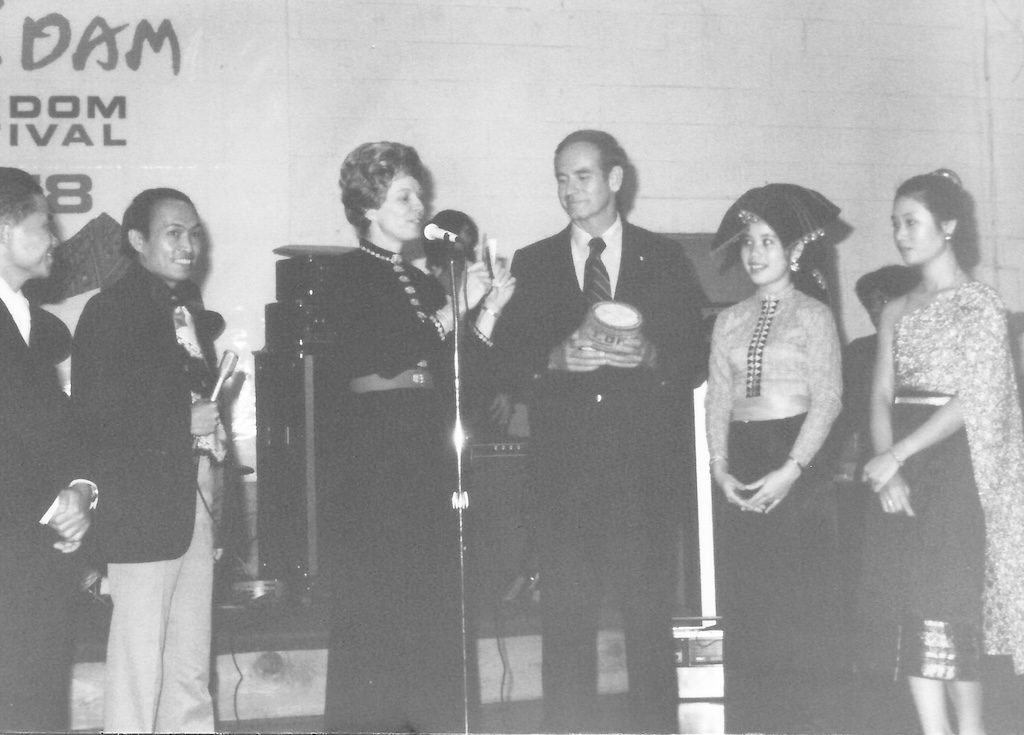
Fifty years ago Gov. Robert Ray began welcoming Southeast Asian refugees to Iowa who were seeking asylum after the Vietnam War. It is perhaps his greatest legacy.
May/June 2025 (Volume 17, Issue 3)
By Matthew Walsh
Fifty years ago, the United States’ involvement in the Vietnam War ended with the fall of Saigon as North Vietnamese troops captured the capitol of South Vietnam on April 30, 1975. During the 1968 Tet Offensive, communists seized Hue and massacred thousands. Some victims were buried alive. Others clubbed to death. Journalists and South Vietnamese investigators found women and children buried in mass graves that dotted the landscape. In April 1975, the U.S. and its South Vietnamese allies thought an even larger bloodbath was about to unfold as communist forces descended on Saigon.
Panic-stricken Vietnamese parents considered killing their own children to spare them from being tortured or murdered by the enemy. Children fathered by U.S. servicemen were left at orphanages by their desperate Vietnamese mothers. Fearing the enemy might not even spare multiracial children, President Gerald Ford authorized Operation Babylift on April 3, 1975. Iowans played a leading role in the humanitarian response. Iowa City residents Carol Helder and LeAnn Thieman traveled to Saigon and rescued 300 of these orphans. Another 2,000 followed.
On April 29, 1975, the U.S. military began the chaotic evacuation of Saigon using helicopters that spirited passengers from the capital to ships of the U.S. Seventh Fleet. Marine pilot Gerald Berry, a Des Moines Tech High School graduate, flew a Sea Knight 18.3 hours in the rescue mission. His helicopter, Lady Ace 09, had been designed to transport 25 soldiers but routinely lifted off with 75-plus passengers. With his second to last load, Berry evacuated U.S. Ambassador Graham Martin from the U.S. Embassy Building. Operation Frequent Wind resulted in the daring removal of about 7,800 Americans, South Vietnamese and third country nationals.
Sadly, not everyone made it out. U.S. Marines Darwin Judge and Charles McMahon died in a rocket attack at Tan Son Nhut Air Base, the last two U.S. combat deaths on the ground in Vietnam. In the hectic withdrawal, their bodies were left behind. It took nearly a year for Judge’s remains to be returned to his grieving parents in Marshalltown. In total, 869 Iowans died in the Vietnam War.
In the summer of 1975, Gov. Robert D. Ray received a letter asking him to help Southeast Asian refugees. Arthur Crisfield, a USAID employee, wrote on behalf of the Tai Dam. Crisfield outlined how this ethnic minority had fought against the communists in Vietnam and then escaped to Laos after the French defeat in 1954. When Saigon collapsed, the group knew Laos would soon follow. In May 1975, they preemptively fled to Thailand and began campaigning for asylum abroad. They sent messages to France, Canada and 30 U.S. governors. Crisfield explained, “Twenty years of fighting the communists has left its toll of dead fathers, uncles, brothers, and sons. Though the Tai Dam have suffered and lost everything several times over, they have not given up the hope of finding peace and freedom somewhere in the world.” Ray ensured that they would find it in Iowa.

Gov. Robert Ray receives a traditional rice basket gift at the Tai Dam Freedom Festival in Des Moines in 1978. Photo courtesy of Houng Baccam
Bringing the Tai Dam to the Hawkeye State proved complicated for Ray. Since the communists did not take over Laos until December 1975, no federal funding existed to resettle refugees from that nation. The Tai Dam had to claim Vietnamese nationality as a loophole. To preserve their culture and stay with loved ones, the Tai Dam wished to be resettled altogether. This violated the U.S. State Department’s policy of dispersing refugees across the nation.
Gov. Robert Ray and President Gerald Ford, pictured in 1976, worked together to rescue Southeast Asian refugees following the Vietnam War. Ray convinced his friend, Ford, to allow Iowa to accept all 3,500 Tai Dam refugees so that they could keep their families intact. Photo courtesy of the Gerald R. Ford Presidential Library
That summer Ray traveled to Washington, D.C., to discuss the dispersal policy. Ray recalled, “I thought there was a good reason for the exception, and so I worked with the State Department and the White House. And I remember making the trip to talk to Henry Kissinger and then Jerry Ford. And in the final analysis they agreed, and they made the exception; and so we were able to invite the Tai Dam to come to Iowa.”
TO READ THE ENTIRE STORY AND OTHER FASCINATING STORIES ABOUT IOWA HISTORY, subscribe to Iowa History Journal.
